商学部(塾外用) - 慶應義塾大学-塾生HP
商学部(塾外用) - 慶應義塾大学-塾生HP
商学部(塾外用) - 慶應義塾大学-塾生HP
You also want an ePaper? Increase the reach of your titles
YUMPU automatically turns print PDFs into web optimized ePapers that Google loves.
Yamamoto T., et al. 1999 Deciding the Public Good: Governance and<br />
Civil Society in Japan. Japan Center for International Exchange<br />
Pekkanen, R. 2006 Japan’s Dual Civil Society: Members without<br />
Advocates. Stanford Univ. Press<br />
MULTIETHNIC JAPAN 2credits (Fall)<br />
多民族社会としての日本 2単位 (秋学期)<br />
Associate Professor, Faculty of Economics<br />
KASHIWAZAKI, CHIKAKO<br />
経済学部准教授 柏崎 千佳子<br />
Course Description:<br />
This course introduces students to 'multiethnic Japan'. Although<br />
Japanese society is often portrayed as ethnically homogeneous, its<br />
members include diverse groups of people such as the Ainu, Okinawans,<br />
zainichi Koreans, and various 'newcomer' immigrants. In this course,<br />
students will learn about minority groups in Japan and their relations with<br />
the majority 'Japanese' population. The goal of this course is to acquire<br />
basic knowledge and analytic tools to discuss issues concerning ethnic<br />
relations in Japan and elsewhere.<br />
Textbooks:<br />
Reading materials consist of excerpts from a variety of sources and will<br />
be provided by the instructor.<br />
INTERCULTURAL COMMUNICATION 2 2credits (Fall)<br />
異文化コミュニケ-ション2 2単位 (秋学期)<br />
Identity of Japanese Sojourners<br />
Professor, Center for Japanese Studies TEZUKA, CHIZUKO<br />
日本語・日本文化教育センター教授 手塚 千鶴子<br />
Course Description:<br />
The first purpose is to help students learn how Japanese people have<br />
been experiencing exciting as well as confusing encounters with cultures<br />
different from their own and how such cross cultural encounters in and<br />
outside of Japan have been affecting their sense of identity and<br />
communication styles as an individual (and as people) from the times of<br />
Japan’s First Opening to the world in the late Edo Period up to the present<br />
from the three perspectives: history, cultural adjustment, and intercultural<br />
communication, utilizing case studies. The second purpose is to help both<br />
Japanese and international students who are brought together to Mita<br />
campus by the globalization and internationalization to make best use of<br />
this class to communicate effectively through discussion and other studentcentered<br />
activities.<br />
Textbooks:<br />
No designated textbook and handouts will be distributed.<br />
Reference Books:<br />
Tsuda Umeko and Women’s Education in Japan by Barbara Ross, Yale<br />
Univ Press, 1992.<br />
The White Plum: a biography of Ume Tsuda by Yoshiko Furuki,<br />
Weatherhieel, 1991.<br />
Intercultural Communication: reader 5 th ed., Larry Samovar and Richard<br />
E Porter, Wadsworth<br />
Publishing Company, 1989.<br />
Japanese Culture and Behavior (revised edition) ed.by Takie Sugiyama<br />
Lebra and William Lebra,<br />
Univ. of Hawaii Press, 1986.<br />
Japanese Patterns of behavior ed by Takie Sugiyama Lebra, Univ. of<br />
Hawaii Press, 1976.<br />
Exploring Japaneseness: on Japanese Enactments of Culture and<br />
Consciousness ed by Ray<br />
95<br />
JAPANESE PSYCHOLOGY IN CONTEMPORARY JAPAN(1)<br />
2credits (Fall)<br />
日本人の心理学(1) 2単位 (秋学期)<br />
Conflict Management<br />
Professor, Center for Japanese Studies TEZUKA, CHIZUKO<br />
日本語・日本文化教育センター教授 手塚 千鶴子<br />
Course Description:<br />
This course is designed to explore how Japanese manage interpersonal<br />
conflict both among themselves as well as in interaction with foreigners,<br />
and its implications for Japanese society which is becoming more<br />
multicultural in this accelerated globalization age. Though a Western<br />
notion of conflict claims that conflict is inevitable yet not necessarily bad,<br />
the Japanese society has been described to believe in its selfimage as a<br />
conflict-free society and to abhor and avoid interpersonal conflicts as any<br />
cost. With this apparent contrast in mind, students will learn<br />
characteristics of Japanese conflict management strategies, their cultural<br />
and social psychological background, and the challenges for both<br />
Japanese and foreigners in trying to creatively deal with intercultural<br />
conflicts. And students will be asked to take some psychological measures<br />
related to conflict for self-understanding.<br />
Textbooks:<br />
No designated textbook and handouts will be distributed.<br />
Reference Books:<br />
Conflict in Japan edited by Ellis Krauss, Thomas Rohren, and Patricia<br />
G.Steinhoff, University of<br />
Hawaii Press, 1990.<br />
Japanese Culture and Society: model of interpretation edited by Kreiner<br />
and Olscheleger,<br />
Monographien 12, Deutschen Institute fur<br />
Japanstudien der Philipp-Franz-von-Siebold-Stiftung, 1996.<br />
Das Wesen von Naikan: the essence of NAIKAN 内観の本質edited by<br />
Prof. Akira Ishii/Shaku Yoko<br />
JOseh Hartl (Hrsg.), altes Wissen, neue<br />
Wege, 2000. (a book in German, English and Japanese)<br />
INTRODUCTION TO POLITICS IN JAPAN 2credits (Spring)<br />
日本政治論 2単位 (春学期)<br />
The history of Japanese politics after World War II<br />
Lecturer AOKI, HIROKO<br />
講師 青木 裕子<br />
Course Description:<br />
The aim of this lecture is to acquire knowledge and thinking ability for<br />
problems that beset modern Japanese society by studying history of<br />
Japanese politics after WWII and reading newspaper articles on current<br />
affairs.<br />
Textbooks:<br />
Materials will be handed out.<br />
Reference Books:<br />
・Duus, Peter (1976). The Rise of Modern Japan, Boston: Houghton<br />
Mifflin.<br />
・Vogel, Ezra F. (2001). Japan as Number One: Lessons for America, San<br />
Jose: iUniverse.com.<br />
・Wolferen, Karel van (1993). The Enigma of Japanese Power: People<br />
and Politics in a Stateless Nation, Tokyo: Tuttle.<br />
・MacMurray, John Van Antwerp (1992). How the Peace was Lost: the<br />
1935 Memorandum, Developments Affecting American Policy in the Far<br />
East, CA: Hoover Institution Press.<br />
・Pinguet, Maurice (1984). La mort volontaire au Japon, Paris: Gallimard.<br />
(English translation by Rosemary Morris(1993). Voluntary death in<br />
Japan,Cambridge, UK and Cambridge, MA : Polity Press.<br />
・Ralws, John (1999). "Fifty Years After Hiroshima," in Collected<br />
papers, Cambridge, Mass. and London : Harvard University Press.<br />
諸<br />
研<br />
究<br />
所




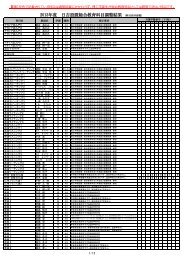
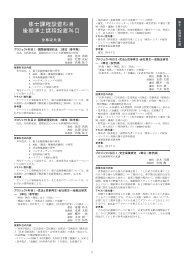
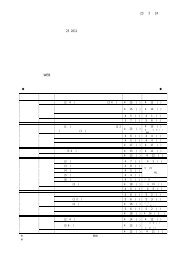
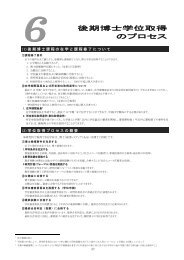
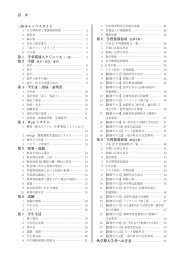



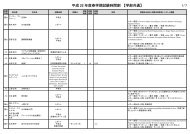

![文学部時間割表[2 ・3年生(07学則)]](https://img.yumpu.com/21046130/1/184x260/2-307.jpg?quality=85)

